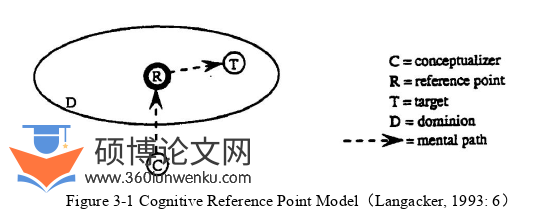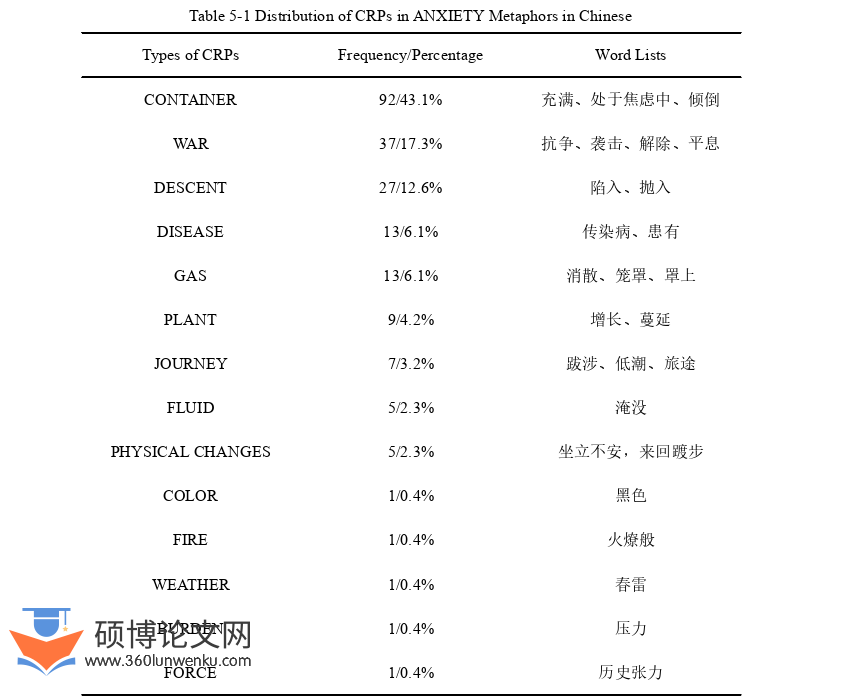本文是一篇英语论文,本研究基于认知参照点理论,探究了情感隐喻的认知路径,揭示了情感隐喻的认知参照点规律,有利于人们理解情感隐喻的认知模式,帮助人们对不同文化中焦虑情感隐喻的形成有更深刻的认识,从而更好地理解语言的本质。
Chapter One Introduction
1.1 Research Background
Emotions are one of the most concerned topics that play a prominent role in humanbehavior and have a significant impact on an individual’s survival and social activities.People use language to convey abstract and complex emotions.In linguistics,metaphor isubiquitous as a vital cognitive tool.Metaphorical expressions are one of the most favorableways to conceptualize abstract emotions and help people understand them better.Emotionmetaphor studies are subordinate to metaphor studies,which have been discussed in multipleacademic areas,especially in cognitive linguistics.In previous studies,scholars have paidmore attention to emotions such as“anger”,“sadness”,“joy”,etc.and focused less on anxietyemotion,which will be discussed in detail in Chapter Two.Against this background,thisthesis attempts to broaden the scope of emotion metaphors by considering ANXIETYmetaphors as a research subject.
The core principle of cognitive linguistics is“reality to cognition to language.”Based onthe experience of social reality,the conceptualizers perceive,process,categorize and organizeexternal things to form certain cognition in the brain and express ideas through language,which is the embodiment of thinking.Langacker’s cognitive reference point model(CRPM)is also based on the above fact.In his model,“target”and“cognitive reference point”form acategory.Because of the salience of the reference point,the target is activated.It is animportant manifestation of the empirical nature of language and is reflected in many complexlinguistic and cognitive phenomena such as possessive constructions,pronoun-antecedentrelationships,topic and topic-like constructions and metonymy(Langacker,1993:1),but lessoften combined with emotion metaphors.Therefore,the choice of theoretical basis ascognitive reference point(CRP)theory makes some sense.

英语论文怎么写
..............................
1.2 Research Purpose and Significance
On the basis of Langacker’s CRPM,this thesis is devoted to modeling the CRPM ofemotion metaphor and to exploring the similarities and differences in the choice of CRPs inANXIETY metaphors between English and Chinese as well as the reasons.The sources ofthe language materials for this thesis are selected from a Chinese corpus and an Englishcorpus respectively.The former is the Center for Chinese Linguistics(CCL)of PekingUniversity.It is a non-profit retrieval system of a purely academic nature with a total of about700 million characters,including a modern Chinese corpus of more than 500 millioncharacters and an ancient Chinese corpus of more than 200 million characters.The corpuscontains spoken language,historical biographies,applied texts,newspapers,literature,etc.,which is rich in types and highly dependable.Among them,the newspaper corpus accountsfor a large proportion and its main part is unprocessed.The English corpus source is theBritish National Corpus(BNC).It is one of the representative contemporary English corporain the world and has a wide range of sources,covering local and national newspapers,magazines and journals,novels,etc.It contains both written and spoken language,and the former takes a large proportion and is highly reliable.The reason for choosing these twocorpora is that they are both based on the written language corpus with strong authority,which makes it possible to conduct a language comparison.At the same time,it can avoid theproblem that the research results are not universal due to the linguistic habits of theindividual language speakers.
................................
Chapter Two Literature Review
2.1 Previous Studies on Emotion Metaphors from a CognitivePerspective
With the publication of The Metaphors We Live By,metaphor has become the domain ofcognitive linguistics.Emotion metaphor,as an aspect of metaphor,has received equalattention from scholars.Throughout searching the relevant literature,it can be found that thecognitive studies mainly focus on analyzing and discussing emotion metaphors with the aidof conceptual metaphor theory,prototype theory and frame semantics theory.The followingsection will organize and illustrate them in chronological order.
2.1.1 From the Perspective of Conceptual Metaphor Theory
Most of the related studies on emotion metaphors are conducted with conceptualmetaphor theory,which reveal the nature of language as a way for human beings to cognizeabstract things and express new ideas.The study based on conceptual metaphor theory wasfirst carried out in foreign countries.Lakoff and Johnson(1980:14)firstly pointed out thata lot of words in English like“up”,“down”,“high”and“low”can be used to express people’sfeelings of happiness,anger,and sadness.For example,there are some expressions like“feeling up”and“feeling down”in English.They believed that such expressions are rooted inphysical experience,that is,the human body’s experience of basic spatial orientation.This was the earliest research on emotion metaphors,focusing on the conceptual system ofmetaphors,i.e.,how to realize the mapping between conceptual domains.Since then,Kövecses,a Hungarian linguist who devoted himself to the study of the conceptualization ofemotions in human language,conducted a more in-depth analysis of the metaphoricallanguage of emotions.First of all,Kövecses(1986)focused on how the three emotions“anger”,“pride”and“love”are internally constructed and discussed their conceptualmetaphorical patterns and the mapping between source domains and target domains.Hefound that the conceptual structure is important to characterize the concepts of this threeemotions.Considering that emotions have a rich conceptualization system,Lakoff andKövecses(1987)jointly proposed that emotions be considered as part of the conceptualcontent through the example of“anger”.The emotion of“anger”is not an intangible feelingbut a complex and elaborate cognitive structure.
..................................
2.2 Previous Studies on Emotion Metaphors from a LiteraryPerspective
Literary works often contain the flow of the author’s emotion,which are often presentedthrough metaphorical expressions.From a literary perspective,the studies are mainly directedat analyzing the types of emotion metaphors and the construction of meaning in literaryworks.The genres of the corpus include novels,poems,etc.Wen Xu and Luo Luo(2004)analyzed the emotion metaphors in I’ll See a Thinner Face than Yellow Flowers andconcluded that the implicit conceptual metaphor is“Humans are plants”.At the same time,they confirmed that the understanding of metaphors cannot be separated from theconstruction of metaphorical contexts and cultural patterns.Lan Chun and Liu Juan(2014)analyzed the image metaphors and“anger”metaphors in the cartoon Dream Man.Theyargued that the image metaphors and the cognitive model of“anger”in the corpus are highlyconsistent with the one observed by researchers in the language.Whether the cognitivemodels of“anger”are presented by images or by language,what they carry is human’sexperience and cognition of the basic emotion of“anger”,which is established on humanphysiological and psychological responses to the emotion as well as the social and culturalexperiences.The only difference is that comics often use a combination of metaphors andmetonymy to express the characters’emotions in an exaggerated way.As one of the fourmajor works of traditional medicine in China,Huangdi Neijing attracts the attention not onlyof the scholars who majored in traditional Chinese medicine,but also the researchers inlinguists.Li Xiaoying and Chen Lili(2017)defined the emotion metaphors in HuangdiNeijing in terms of seven different categories,such as orientation,weather and color,toreveal how they play a role in the conceptualization and categorization of abstract emotionalexperiences in Chinese medicine and reconfirmed that metaphors are indeed the way humansthink about the world from a cultural perspective.
.................................
Chapter Three Theoretical Framework.............................20
3.1 Cognitive Reference Point Theory..............................20
3.1.1 The Development of CRP Theory..............................20
3.1.2 Characteristics of CRPs...................................22
Chapter Four Cognitive Reference Point Model of Emotion Metaphor........................31
4.1 The Feasibility of Combining CRP Theory with Conceptual Metaphor Theory........31
4.2 CRPM of Emotion Metaphor.....................33
Chapter Five Results and Discussion of CRPs of ANXIETY Metaphors in English andChinese..............................38
5.1 Comparison of the Types of CRPs of ANXIETY Metaphors in English and Chinese....................38
5.1.1 The Distribution of CRPs of ANXIETY Metaphors in English and Chinese...38
5.1.2 Similar Types of CRPs of ANXIETY Metaphors in English and Chinese.......41
Chapter Five Results and Discussion of CRPs of ANXIETYMetaphors in English and Chinese
5.1 Comparison of the Types of CRPs of ANXIETY Metaphors inEnglish and Chinese
After searching and analyzing the data in the corpus,various CRPs are highlighted inANXIETY metaphors.Firstly,the types of CRPs will be shown below.At the same time,thesimilarities and differences between English and Chinese will also be presented.
5.1.1 The Distribution of CRPs of ANXIETY Metaphors in English andChinese
By searching for the word“焦虑”in the Chinese corpus,there are 2787 relatedexpressions.Among them,213 sentences with anxiety metaphors are obtained according tothe metaphor identification strategy.By categorizing the source words of metaphors involved“焦虑”into semantic categories at an abstract level,14 different types of CRPs are found inChinese.The most frequently used one is“container”,followed by“war”and“descent”,“disease”,“gas”,“plant”,“journey”,“fluid”and“physical change”.Five of these categoriesappear only once,including“color”,“fire”,“weather”,“burden”and“force”.Table 5-1shows the types of CRPs in descending order of frequency of occurrence and proportion.Theword lists demonstrate the linguistic expressions in which a particular category of a CRP ispresented.

英语论文参考
..............................
Chapter Six Conclusion
6.1 Major Findings
Based on the CRP theory,this thesis compares the commonalities and characteristics ofthe CRPs chosen for cognizing ANXIETY metaphors in English and Chinese corpora andanalyzes the reasons for this.According to the analysis and discussion above,the mainfindings are as follows:
Firstly,the CRPM of emotion metaphor is a simple application of Langacker’s CRPM,integrating conceptual metaphor theory with CRP theory,which is based on the fact that thesource domains in conceptual metaphors can act as reference points and that the targetdomains are emotions to be recognized and understood by conceptualizers.The cognitivepaths between them are similar and are connected by similarities between CRPs and targets.Its working principle is that:in order to understand the target(T),the conceptualizer(C)choose an entity in cognitive dominion(D).Reference point(R),characterized by a certaindegree of similarities between some salient features of reference point(R')and those of thetarget(T'),is highlighted and becomes the center of conceptualizer and thus establishes apsycho-cognitive path to activate the emotion concept.
Secondly,by comparing and analyzing the corpus of ANXIETY metaphors in Chineseand English,it can be found that both people use CRPs to cognize emotions and there is aremarkable similarity in the choice of CRPs.Overall,the number of CRPs used in English isslightly higher than that in Chinese.Specifically,the two enjoy a large number of similartypes of CRPs.They are“container”,“descent”,“disease”,“plant”,“war”,“journey”,“liquid”,“gas”,“force”,“fire”,“physical change”,“burden”and“color”.The first eightoccur with higher frequency,while the rests appear less frequently.
reference(omitted)
